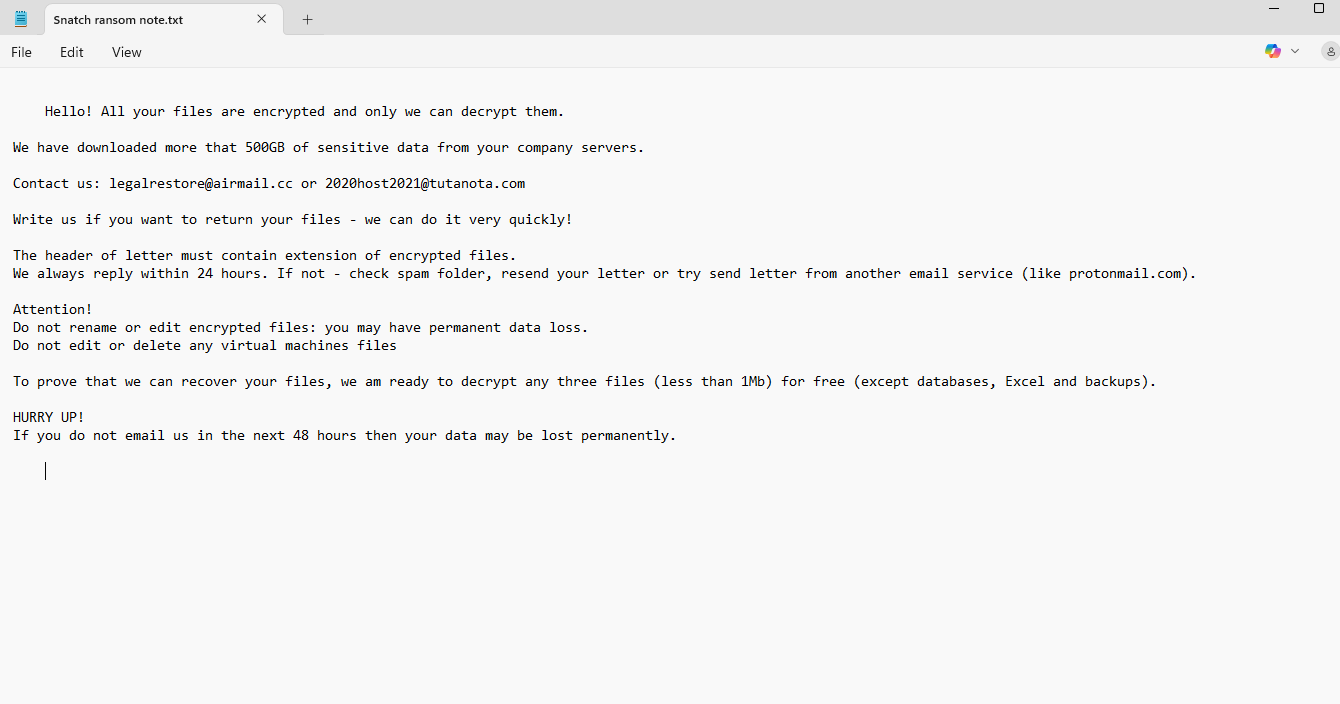First discovered in late 2019, Snatch is a ransomware group known for its unusual and technically advanced tactics, including rebooting infected systems into Safe Mode to bypass security tools. This unique approach allows it to encrypt files with minimal resistance, making it a formidable threat.
A Snatch ransomware infection usually leads to a full system lockdown, encrypting files and displaying a ransom note that demands payment in cryptocurrency. The note instructs victims to contact the attackers via email or a Tor-based website and threatens to expose their data to further pressure compliance.
A break-in at your offices would compel you to call the police immediately and touch nothing until they arrive, understanding the need for forensic work to take place. A cyber-attack requires the same action.
This is not a job for your IT team or MSP. There are Digital Forensic specialists available 24/7 who can assist you.


Snatch has been active since at least December 2019 and is believed to be operated by a Russian-speaking cybercriminal group. Unlike many ransomware operators who use off-the-shelf tools, Snatch is built using a custom ransomware variant designed to evade detection.
What sets Snatch apart is its ability to reboot infected Windows machines into Safe Mode, where many endpoint protection tools are inactive. Once in Safe Mode, it proceeds to encrypt files with little to no interference. This technique has been widely regarded as a clever and rare method to bypass even well-configured security solutions.
Snatch targets organisations across various sectors, including construction, manufacturing, IT, and public services. The group uses double extortion tactics, exfiltrating data before encryption to further pressure victims into paying a ransom.
Snatch typically gains access through compromised Remote Desktop Protocol (RDP) services, brute-force attacks, or by exploiting weak passwords. Once inside a network, the group moves laterally to identify critical systems and data.
Before deploying the ransomware payload, attackers often exfiltrate sensitive files and upload them to remote servers. They then initiate a forced reboot of the system into Windows Safe Mode, during which the encryption process occurs. This reduces the likelihood of antivirus or endpoint detection systems interrupting the attack.
Snatch has been active since at least 2019, making it one of the longer-running ransomware groups still in operation. Its activity has been relatively consistent over the years, targeting medium to large organisations across Europe and North America, claiming 142 victims to date.
Solace Cyber’s track record includes hundreds of successful response recoveries, providing Digital Forensic Incident Response services, 24x7x365.
“UK businesses take an average of 38 days to identify a cyber-attack and 43 days to recover fully.”

Solace Global was founded in 2010 as global experts in risk management and security, offering services such as Travel, Crisis, and Offshore Risk Management. With a 24/7 Security Operations Centre and an in-house intelligence team providing daily and weekly reports, Solace Global is accredited to ISO 27001, 14001, 45001, and 9001 standards.
Solace Cyber was established in 2021, specialising in Cyber breaches, particularly Digital Forensics and Incident Response, Ransomware, Risk Management, and Information Security, along with Managed Security Services. The leadership team collectively possess over 20 years of experience in the IT and security industry. Solace Cyber is accredited to ISO 27001.
s
%+
A forensic analysis needs to be meticulous and a clean restore and recovery requires a wealth of experience not normally available in an in-house team who must provide a broader range of IT support skills:


Solace Cyber was established precisely for this scenario. We have a well-defined process for handling cyber-attacks like Snatch, which involves a 6-step approach:
It includes a thorough digital forensic analysis from step 2 where the output becomes a central component of business recovery. This is because understanding the attack is of critical importance:
It is critical that the analysis of digital evidence is carried out to an agreed plan. This will have been designed to provide the best and earliest chance of discovering a root cause, which is essential to inform remediation/eradication and recovery as well as supporting a legal take-down case if this is applicable. A legal take-down means we can assist in the legal enforcement that stops the criminals from publishing the data, thus undermining the ransom notice.
Solace’s Digital Forensic and Incident Response teams maintain consistent communication throughout. Dedicated Incident Managers and technical engineering leads provide updates during the Cyber Incident Response journey, utilising risk registers and working within change management processes, all from triage through to post-incident, delivering successful business recovery.
Solace Cybers' assistance extends beyond recovery. After restoring your business operations, we work collaboratively to ensure your cyber security posture is robust using a threat-informed methodology. This involves leveraging our comprehensive 9-step framework known as the Solace Global - Cyber 9 Step Process.
Yes, Snatch is a highly sophisticated form of ransomware. It encrypts data, steals sensitive information, and demands a ransom—typically in cryptocurrency. Its Safe Mode encryption technique is one of the reasons it is considered more advanced than many other ransomware strains.
A Snatch ransomware attack generally enters a system in one of the following ways:
We recommend you adopt policies to:
After recovering from Snatch Solace Cyber recommends that you update your business continuity plan to account for lessons learnt during this attack & recovery.
The average cost of ransomware breaches hover around £500K, while smaller email data breaches typically incur expenses of around £50K. A critical decision emerges between preserving the environment for forensic analysis or opting for swift recovery to minimise business disruption. Delays in identifying and resolving breaches only exacerbate costs.
Cybersecurity insurance claims entail a multifaceted process, encompassing reasonable expenditures for investigation and remediation, alongside coverage for legal, business interruption, criminal liability, employment liability, and ransom policies. While the insurance industry plays a pivotal role in facilitating business recovery, cyber insurance is perceived as volatile within the sector, and many policies require meticulous validation.
Facing genuine pressure, there's a crucial decision to make - one that could rescue your organisation from weeks of operational standstill, reputation damage, and client data loss. Yet, the probability of a favourable outcome remains slim, emphasising the importance of engaging a specialised ransomware incident response team. They are your most viable recourse for navigating a ransomware incident.
The NCSC have documented the deliberations for paying ransomware: https://www.ncsc.gov.uk/ransomware/home
Important Reminder: It is a criminal offense to pay money to people who are subject to financial sanctions. The list of who is subject to financial sanctions is constantly changing.
The latest iteration can be found here: https://www.gov.uk/government/publications/financial-sanctions-consolidated-list-of-targets
Yes. There's a possibility that some of the lost data contains "Personal Data" belonging to your customers. Safeguarding such data is a legal requirement, so it's important to consider notifying the Information Commissioner's Office (ICO) about this incident, as well as your customers. https://ico.org.uk/
Your insurer or legal counsel will provide guidance on the necessary steps and how to proceed in this matter. However, Solace Cyber has experience collaborating with insurers and legal representatives and can offer assistance in managing these relationships during this challenging period.
Your business operations may experience significant disruptions. These could include:
To mitigate these effects, it's crucial to have a comprehensive incident response plan in place, including communication strategies, collaboration with cybersecurity experts, and measures to enhance system resilience and data protection. Additionally, transparency with stakeholders and proactive steps to rebuild trust can help minimize the long-term consequences on your business.
Action Fraud is the UK’s national reporting centre for fraud and cybercrime. Whether you have been scammed, defrauded, or experienced cybercrime in England, Wales, or Northern Ireland, Action Fraud offers a central point of contact for information on fraud and financially motivated cybercrime.
If your systems are showing signs of an Snatch attack, REMAIN CALM.
YOU MUST NOT TOUCH THEM, RESTORE OR OVERWRITE THE DATA (explanation above).
Contact Solace Cyber on 01202 308818 or complete our form for a call back from one of our experts.
We will act promptly to reduce your business downtime.

Solace Cyber, part of Solace Global, helps companies across the UK recover from ransomware attacks and data breaches.
SOLACE GLOBAL CYBER LTD is registered in England & Wales no. 08830710

Solace Global
Twin Sails House,
W Quay Rd,
Poole, BH15 1JF
United Kingdom